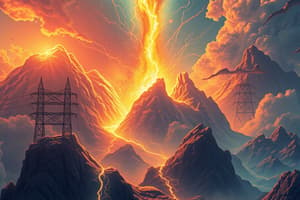Podcast
Questions and Answers
Which energy source produces greenhouse gases only during its construction?
Which energy source produces greenhouse gases only during its construction?
- Fossil fuels
- Coal
- Renewable resources (correct)
- Nuclear energy
Fossil fuels can be reused and will last indefinitely.
Fossil fuels can be reused and will last indefinitely.
False (B)
How much energy does running use per minute?
How much energy does running use per minute?
60kJ
The energy content of an apple is ___ kJ per 100g.
The energy content of an apple is ___ kJ per 100g.
Match the following energy sources with their classification:
Match the following energy sources with their classification:
What does the law of conservation of energy state?
What does the law of conservation of energy state?
Thermal energy and temperature are the same thing.
Thermal energy and temperature are the same thing.
What type of energy transfer occurs when particles collide in solids?
What type of energy transfer occurs when particles collide in solids?
In a convection current, the ______ part rises while the cooler part falls.
In a convection current, the ______ part rises while the cooler part falls.
Match the following methods of thermal energy transfer with their descriptions:
Match the following methods of thermal energy transfer with their descriptions:
How is power defined in relation to energy?
How is power defined in relation to energy?
What is the formula for work done?
What is the formula for work done?
Insulated houses require more power to maintain thermal energy.
Insulated houses require more power to maintain thermal energy.
Flashcards
Law of Conservation of Energy
Law of Conservation of Energy
The total energy in a system remains constant, it cannot be created or destroyed, only transferred from one form to another.
Temperature
Temperature
A measure of the average kinetic energy of particles within a substance.
Thermal Energy
Thermal Energy
The total amount of thermal energy stored in a substance.
Conduction
Conduction
Signup and view all the flashcards
Convection
Convection
Signup and view all the flashcards
Radiation
Radiation
Signup and view all the flashcards
Power
Power
Signup and view all the flashcards
Work Done
Work Done
Signup and view all the flashcards
Energy
Energy
Signup and view all the flashcards
Fossil Fuels
Fossil Fuels
Signup and view all the flashcards
Renewable Energy
Renewable Energy
Signup and view all the flashcards
Thermal Power Station
Thermal Power Station
Signup and view all the flashcards
Greenhouse Gases
Greenhouse Gases
Signup and view all the flashcards
Study Notes
Conservation of Energy
- Energy cannot be created or destroyed, only transferred.
- Total energy before a transfer equals total energy after.
- Energy transfer methods include light, sound, and electricity.
Measuring Energy
- Temperature is measured in degrees Celsius (°C), representing average energy.
- Thermal energy represents total energy.
- A warm bath has more thermal energy than a heated kettle, even if the kettle is hotter.
Heating
- Heating increases particle kinetic energy, causing faster vibration.
- Heating an object's energy need depends on mass, material, and temperature change.
- Equilibrium occurs when objects have equal thermal energy.
Energy Transfer
- Thermal energy transfers via conduction, convection, and radiation.
Conduction
- Particles in solids transfer energy through collisions.
Convection
- In liquids and gases, heating causes particles to move faster, become less dense, and rise.
- Cooler, denser particles sink, creating a convection current.
Radiation
- Energy transfer without particles, through waves.
- All objects emit radiation, the amount depending on temperature and surface properties (color, smoothness).
- Radiation can be absorbed or reflected.
Power
- Power is the rate of energy transfer (energy per second).
- Energy bills are measured in kilowatt-hours (kWh).
- Converting kWh to joules requires converting time to seconds.
Energy Bills Calculation
- A 2 kW device uses 4 kWh.
- Energy bills include fuel costs, power station costs, staff, and infrastructure.
Reducing Energy Bills
- Use fewer or more efficient appliances.
- Insulation reduces thermal energy loss in homes to lower energy needs.
Work, Energy, and Machines
- Work done = Force × Distance
- Simple machines, like levers and gears, make work easier, but conserve energy.
Energy in Food and Activities
- Food energy varies; examples including 200 kJ/100g apple, 1000 kJ/100g chips.
- Activity energy needs vary; examples including 6 kJ/minute sitting, 60 kJ/minute running.
Renewable Resources
- Renewable resources (wind, tidal, wave, hydroelectric, geothermal, biomass, solar) produce greenhouse gases while being built but not when used and are sustainable.
Non-Renewable Resources
- Non-renewable resources (coal, oil, gas) formed from fossilized remains are not reusable and will eventually run out.
- They are used in thermal power stations to heat water, producing steam and turning turbines that spin generators.
- Fossil fuels produce greenhouse gases.
Energy Sources and Transfers
- Energy is stored in chemical form in food and fuels.
- Energy is measured in joules (J).
- Different activities require different amounts of energy.
Studying That Suits You
Use AI to generate personalized quizzes and flashcards to suit your learning preferences.
Description
Explore the fundamental concepts of energy conservation, transfer methods, and measurement. This quiz covers topics such as conduction, convection, and the relationship between temperature and energy. Test your understanding of how thermal energy behaves in different scenarios.




